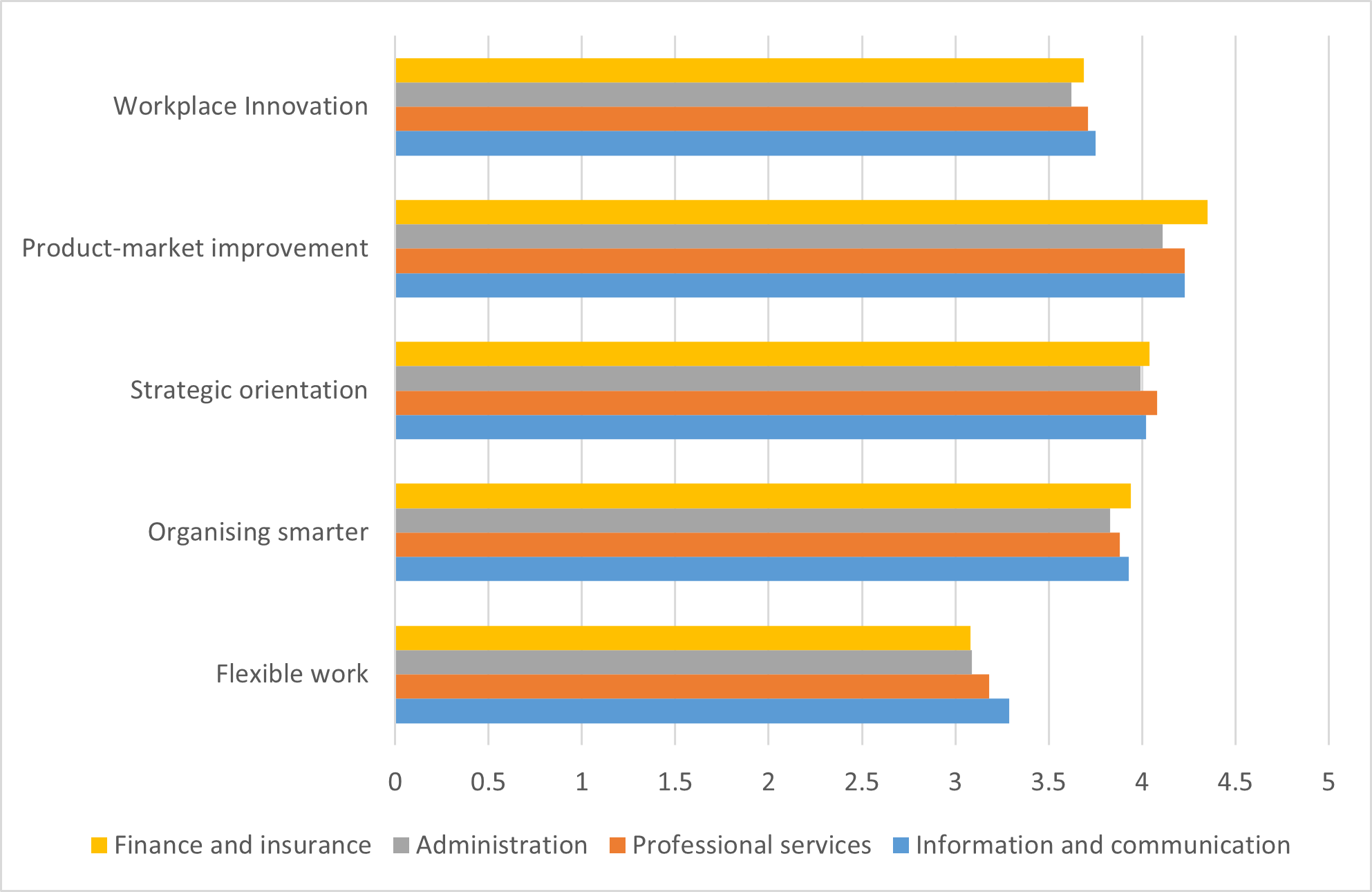Workplace innovation and quality of working life – evidence from Poland

Zofia Mockałło
CIOP-PIB, Warsaw
Years of research on workplace innovation have proved that WPI can improve employees wellbeing and organisation’s performance (e.g. Totterdill, 2015). However, as demonstrated in the third and fourth European Company Surveys (Eurofound, 2015; Eurofound & Cedefop, 2020), workplace innovation cases in Central and Eastern Europe were less substantial compared to Continental and Western Europe countries. According to Eurostat data, only 15.5% of Polish companies introduced non-technological innovation (Nieć, 2015). In this short article, I would like to share results on the prevalence of workplace innovation in Polish service companies and how it relates to quality of working life in terms of workplace social capital, work engagement, work ability and intent to leave.
We took the following definition which describes workplace innovation as “an organisational capability, defined as a strategic renewal in organising and organisational behaviour. This capability may consist of four resources: strategic orientation, product-market improvement, flexible work and organising smarter (Oeij & Vaas, 2016, p. 101). We followed this approach, studying the four types of resources and their relationship to: workplace social capital, work engagement, work ability, and intent to leave. We thought that workplace innovation may – through new ways of organising working time and work itself, or by focusing on development and networking – create an environment in which employees develop networks, have the opportunity to work with others and become more trusting of their co-workers and superiors in the process of implementing new tasks. Similarly, by streamlining processes, networking, allowing employees to adjust work to their capabilities and needs, workplace innovation can lead to greater work engagement and positively affect the wellbeing of employees.
Who took part in the study?
500 employees took part in the study. They worked in four branches of service industry: information and communication technologies, professional services, administration and support services, finance and insurance, across 15 Polish regions. Approximately 67% of the respondents were women. The average age of the respondents was 37 and most of them (57%) were university graduates.
What were the results?
Prevalence of workplace innovation in the study group
The overall level of the Workplace Innovation Index and of individual subscales in the four surveyed industries was quite similar (Figure 1). Only companies in the finance and insurance industry introduced product-market improvement changes significantly more often, compared to companies in the administration and support services industry. The latter were also considerably more reluctant to introduce elements of flexible work than ICT companies.
Data from the Polish Central Statistical Office (Nieć, 2015) show that three out of four branches taken into account in the study (i.e. ICT, Finance and Insurance and Professional services) are among the most innovative in Poland, and that companies in the service industry are more likely to introduce non-technological innovations than technological ones. This fact might have translated into a higher workplace innovation score in this study.
Surprisingly, the level of the overall workplace innovation and its different types resembles the results of study conducted in Dutch companies (Oeij et al., 2010). The least common type of workplace innovation was flexible work, while the most frequent was product-market improvement, followed by strategic orientation and organising smarter. It seems interesting that despite differences between the surveyed groups, their size, industries, or even countries (and their development levels), the same forms of workplace innovation were implemented in enterprises with more or less equal frequency.
The size of the organisation has had an impact on the introduction of WPI into the Polish sample. Micro and small enterprises were significantly more engaged in workplace innovation than medium-sized enterprises.
Workplace innovation and quality of working life
The results of this study appeared to be consistent with these assumptions, proving the significant role of workplace innovation. However, it was interesting to see which type of the four workplace innovation resources was responsible for which outcome (Table 1).
Statistical analysis showed that strategic orientation was the factor related to all positive outcomes: higher levels of social capital at work, work engagement, work ability, and lower intent to leave the job. This result proves that the company’s growth can go hand in hand with personal development and the contentment of staff who also benefit from their organisation’s focus on learning and from knowledge acquisition from external sources. Therefore, orientation towards the external environment and building social capital externally are also reflected in the level of social capital within the organisation.
Flexible work was responsible for higher levels in work engagement which may be due to the fact that such employees are willing to be more involved in their work when they feel they can influence their working conditions in order to optimise them.
Table 1: Relationships between workplace innovation resources and the quality of working life dimensions
|
|
Social capital at work |
Work engagement |
Work ability |
Intent to leave |
|
Strategic orientation |
+ |
+ |
+ |
– |
|
Flexible work |
n.s. |
+ |
n.s. |
n.s. |
|
Organising smarter |
+ |
n.s. |
n.s. |
n.s. |
|
Product – market improvement |
+ |
n.s. |
+ |
n.s. |
+ means the relationship is positive; – means the relationship is negative; n.s. means the relationship is not significant
Smart organising was related to higher levels of social capital. It seems that in this type of innovation, employees have access to other members of the network; unusual combinations of workers, e.g. from different organisational units or departments “impose” cooperation and trust on them, which is conducive to social capital growth.
Product-market improvement was a resource related to higher levels of social capital and work ability. This particular dimension of workplace innovation means focusing on innovation: improving or developing new products and services. This attitude may encourage new relationships, cooperation development and trust building between employees or between employees and managers which would explain higher levels of social capital related to it. The relation with work ability may probably be explained by other factors present in such a working environment. Such a result could serve as a partial example of prof. Frank Pot’s statement: “by introducing workplace innovation, improvement of quality of working life (QWL) and organisational performance can be achieved simultaneously” (2011, p. 405). Even if the product-market improvement factor is not directed towards improving work ability of employees, it creates the environment which supports employees in adapting their work to their capabilities.
Conclusions
In Polish organisations that had introduced extensive workplace innovations, employees built more harmonious relationships with their colleagues, based on trust, support and streamlined cooperation, characterised by a higher level of social capital. They were also more engaged in their work and evaluated their ability to work higher – that is, they felt that their work did not surpass their physical or mental capabilities. Finally, they rarely expressed the intention to change their jobs compared to the employees of organisations reluctant to introduce workplace innovation.
This article is based on: Mockałło, Z. (2016). Innowacje w miejscu pracy i ich związek z jakością życia zawodowego – z kapitałem społecznym, zaangażowaniem w pracę i samopoczuciem pracowników. [Workplace innovation and its relationship to the quality of working life – social capital, work engagement and employee wellbeing]. In: M. Strumińska-Kutra i B. Rok (red.), Innowacje w miejscu pracy. Pomiędzy efektywnością a jakością życia zawodowego [Workplace innovation. Between efficiency and the quality of working life] (p. 291-316). Warszawa: Poltext
Eurofound (2015). Third European Company Survey – Workplace innovation in European companies. Luxembourg: Publications Office of the European Union
Eurofound & Cedefop (2020), European Company Survey 2019: Workplace practices unlocking employee potential, European Company Survey 2019 series, Publications Office of the European Union, Luxembourg.
Nieć, M. (2015). Działalność innowacyjna przedsiębiorstw w Polsce na tle krajów Europy, W: P. Zadura-Lichota (red.) Innowacyjna przedsiębiorczość w Polsce, Warszawa: PARP
Oeij, P. R., & Vaas, F. (2016). Effect of workplace innovation on organisational performance and sickness absence. World Review of Entrepreneurship, Management and Sustainable Development, 12(1), 101-129.
Oeij, P., Dorenbosch, L., Klein Hesselink, J., & Vaas, F. (2010). Slimmer werken en sociale innovatie. Integrale organisatievernieuwing. Den Haag: Boom|Lemma.
Pot, F. (2011). Workplace innovation for better jobs and performance. International Journal of Productivity and Performance Management, 60(4), 404-415.
Totterdill, P. (2015). Closing the gap: The fifth element and workplace innovation. European Journal of Workplace Innovation, 1(1), 55-74.
Share This Story!

European Workplace Innovation Network (EUWIN)
EUWIN was established by the European Commission in 2013 and is now entirely supported by contributions from an international network of partners co-ordinated by HIVA (University of Leuven). EUWIN also functions as a network partner for the H2020 Beyond4.0 project.
Contact: Workplace Innovation Europe CLG (contact@workplaceinnovation.eu).
